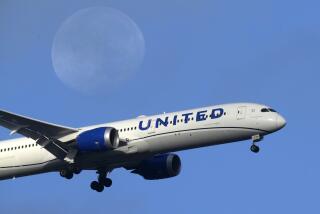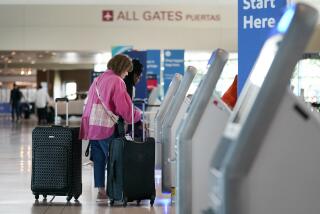The most fun you can have with air miles, on the ground
Question: From years ago, I have about 115,000 American Airlines miles. I am now partly handicapped, and I cannot see ever again taking an airline trip. I have heard of other uses for the miles, buying merchandise, etc., but I can’t see much of anything for sale. I would like to use them to get rid of them because I have to renew the date of their expiration every year.
Howard Oxman
Thousand Oaks
Answer: Buy more newspapers. For a mere 3,000 miles, you can get a seven-day subscription to the Los Angeles Times for almost 18 years.
Although I find that the best use of Oxman’s miles, it’s not the only one.
When it comes to merchandise, American will also let you buy magazines (and, yes, newspapers other than The Times), but its choice of other items is not quite as broad as, say, Delta’s.
Through Delta’s SkyMiles Merchandise (marketplace.delta.com), you could buy a Movado Classic Museum Gent’s Watch or a BOB SE Revolution Stroller with miles to spare.
Miles purists will note that you’re not getting very good value for those kinds of purchases. Estimates of what a mile is worth vary from half-a-cent to more than 5 cents a mile, but 1 cent seems to be the most common value. With that as the basis, you would be paying about $840 for a watch that costs about $500 and $950 for a stroller that should be about $400.
Through Points.com, you can redeem American miles for gift cards that can be used for merchandise, said Brian Karimzad, director of Milecards.com, a website that lets you compare travel reward cards. Like the Delta program, the cards don’t offer the best financial return, he said.
There are altruistic uses for those miles too. American accepts donated miles for Operation Hero, which lets family members and close friends of those injured while serving in Iraq or Afghanistan travel to military hospitals to see their loved one. Info: bit.ly/1rLwQUZ
American also accepts donated miles for Kids in Need, which helps young people with “medical, educational or social services issues,” AA’s website says. Miles have gone to such organizations as Dana-Farber Cancer Institute/The Jimmy Fund, Make a Wish Foundation and St. Jude Children’s Research Hospital. Info: bit.ly/1oCxfGT
Don’t donate, however, thinking you’ll get a tax break; you won’t. Matthew Goldman, founder and chief executive of Wallaby Financial, a software startup that aims to help consumers get the most out of their credit cards and everyday shopping, said the silver lining here is that no tax break means you’re not paying taxes on the miles you accumulate.
Goldman likes using his miles for hotels. Oxman could put up visitors at the Langham Pasadena for two nights for 102,000 miles or for six nights at the Ramada Burbank Airport for its on-sale prices of 19,025 points a night. (Mileage amounts may vary according to sales.)
In the end, the best use of those hard-earned miles is what works best for you, and don’t let anyone tell you differently unless, of course, it has to do with newspaper subscriptions.
Update: In the July 20 On the Spot [“An Illuminating Lesson”], reader Suzanne Beck of Long Beach outlined an issue she had with Vayama’s customer service. She had arrived late for her flight from Florence, Italy; Lufthansa, the airline, had already closed the door. She could not get help with rebooking from the airline because her ticket was booked through a third party: Vayama. She had been directed to Vayama from Kayak.com, an airfare aggregator site.
Because Beck was listed as a no-show, her ticket had no value, and Lufthansa would not refund money or credit her. Vayama, which had failed to respond in a timely manner to her request for help, sent her a voucher for $500 as a goodwill gesture.
The lessons from Beck’s experience may prove more valuable, including this one: If you are redirected to a site, make sure you know what that site is.
Vayama sells consolidator tickets, which are usually cheaper. But if you have a problem with one, you’re on your own unless you’ve used a travel agent or have a relationship with that consolidator.
This was about a $3,200 lesson. My wallet cringes just hearing that.
Have a travel dilemma? Write to travel@latimes.com. We regret we cannot answer every inquiry.
More to Read
Sign up for The Wild
We’ll help you find the best places to hike, bike and run, as well as the perfect silent spots for meditation and yoga.
You may occasionally receive promotional content from the Los Angeles Times.







